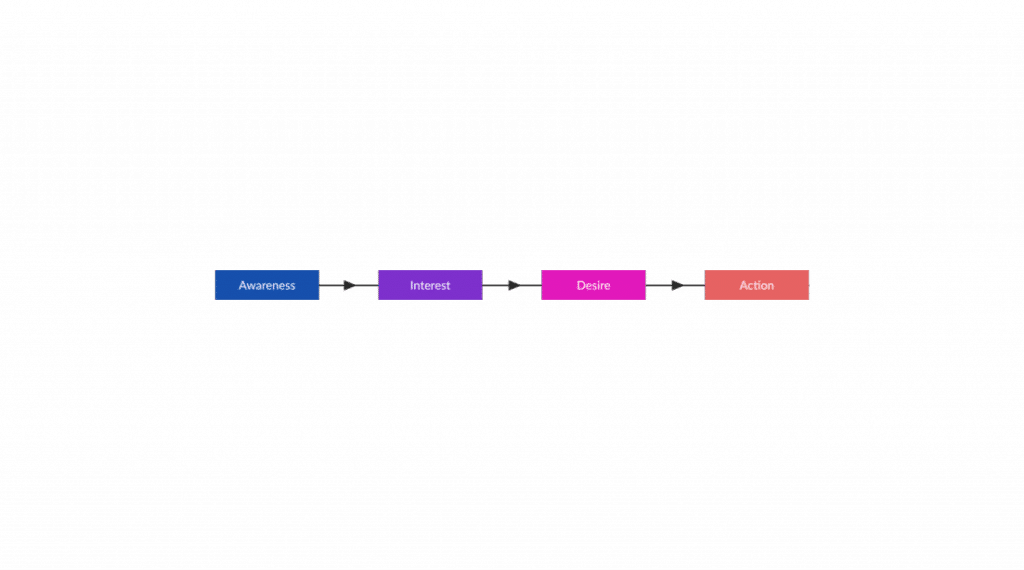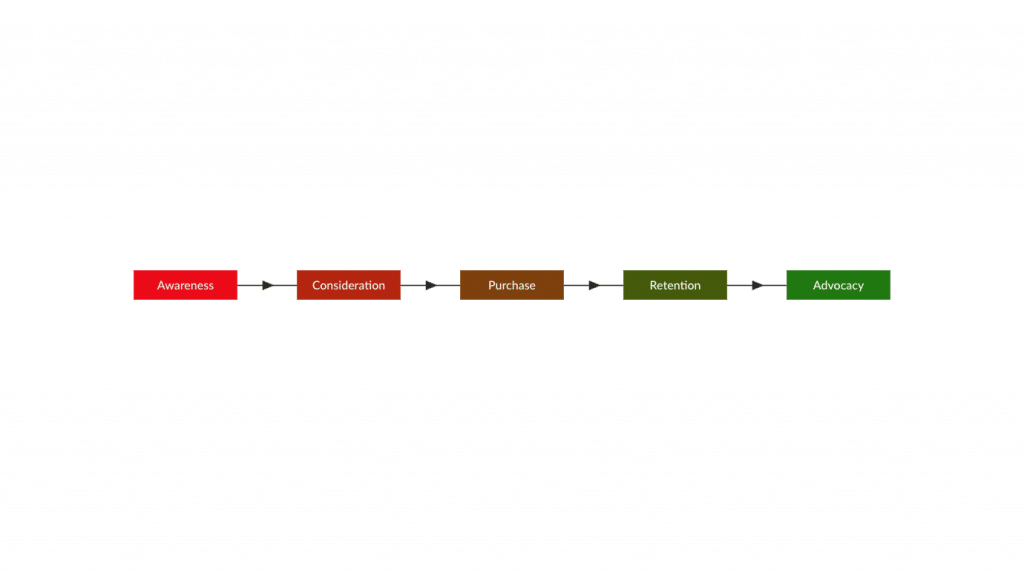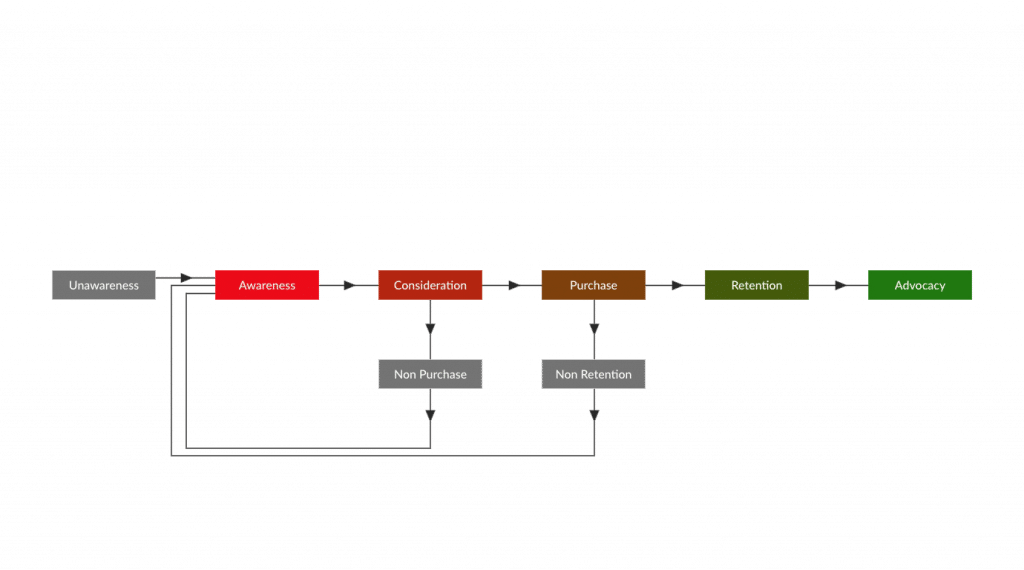Before we start with the five phases of the customer journey, let me briefly explain where they originally came from or, in other words, which model the phases are based on.
In 1898, Elmo Lewis developed a stage model that divides advertising effectiveness into four phases that the customer goes through until he or she decides to buy.
This model is called “AIDA” because it is an acronym for the following four phases, which are based on the psychological findings of the perceptual processes of communication:
- Attention
- Interest
- Desire
- Action

Although the model has been around for many, many years, it is still very often used today in advertising strategies, promotional activities and sales pitches.
As already mentioned, the AIDA model also plays an important role in the customer journey.
This is because a customer’s journey is classically described using the AIDA model and its linearity.
However, the mixing of offline and online channels as well as the behavior in the post-purchase phase, which is not taken into account in the stage model, makes it necessary to expand the original model for describing the customer journey to include additional phases.

This extension resulted in the ACCRA model, which is an acronym for Awareness, Consideration, Conversion, Retention, and Advocacy and describes the customer journey in more detail.
Let’s now take a detailed look at the five phases of the customer journey:
1st Phase: Attention (Awareness)
A customer’s journey often begins with the awareness that he or she has a problem or need that should be solved by a product or service.
In this context, a potential customer searches for initial information, for example through an Internet search, through participation in trade fairs or through exchanges with family, friends and acquaintances, and thus often becomes aware of possible products and services for the first time.
The goal of a company in this phase of the customer journey should be to generate attention for itself and its offered solution through various marketing measures.
If the company, product or service is ultimately on the radar of the potential customer, interest begins to grow in the next step.
2nd Phase: Interest (Consideration)
Now that the potential customer knows that there are various approaches to solving his problem or need, he researches more intensively, selects and compares in order to find the best solution for him.
Companies should therefore support the customer on the decision-making process with detailed and goal-oriented information, whether via the website, comparison portals or customer service, and assist the potential customer with his concerns and questions.
3rd phase: Purchase (conversion/purchase)
After the potential customer has decided on a product or service, the purchase takes place.
The purchase should have no obstacles at all, or as few as possible, so that a quick conclusion can be reached.
4th Phase: Binding (Retention)
After the customer has made a purchase, the retention phase begins.
While the classic AIDA model does not consider the customer journey after the purchase, the ACCRA model is different.
This is because in the retention phase, companies must continue to offer the customer a positive experience. They must not disappoint him and should meet his expectations as best they can.
From time to time, a company should ask for feedback from its customers to get an impression of satisfaction.
5th Phase: Brand ambassadors (advocacy)
Satisfied customers are happy to recommend companies and their products to others.
Here, companies should turn customers into credible brand ambassadors through a good customer experience.
After all, positive recommendations and the exchange of credible customer experiences are effective sales-promoting tools.
Are there other possible phases in the customer journey?
Yes, there are.
Over time, the 5 phases of the Customer Journey have also evolved and been expanded to include the following phases:

Phase: Ignorance (Unawareness)
This phase occurs before the attention phase and describes the case where the potential customer does not yet know anything about his problem, his need, or the product/service.
Companies can already position themselves well at this point through targeted content marketing and awaken the need in advance.
Phase: No purchase intention (Non Purchase)
Whether a customer buys a product or service depends on the decision he makes in the consideration/interest phase. This is because all the information he has gathered there about the product and the company to solve his problem/need forms his opinion.
A non-purchase does not necessarily lead him to ignore the product/company.
There is still a possibility that he will return to the attention phase and still consider making a purchase.
Phase: No customer retention (Non Retention)
The customer has purchased, but is disappointed with their experience of the product after purchase or the company itself. As a result, they become dissatisfied over time and look for alternatives in the long term or break off the relationship altogether.
This is precisely where the company should make it its business to find out how this dissatisfaction could have come about, in order to optimize the post-purchase experience.
It can help to conduct regular surveys at different touchpoints along the retention phase.
The feedback received can then be used to derive targeted measures to improve after-sales service and meet customers’ expectations and wishes.
Conclusion: Provide seamless interaction and good communication along the entire customer journey
In this article, I explained to you which phases a customer goes through along his customer journey.
For companies, this means not only serving all phases, but also convincing them. After all, the previously unknown customer should be a satisfied and loyal customer at the end of the journey.
To do this, marketing, sales, and customer service must provide seamless interaction and good communication at each stage to provide trust along all phases of his journey through an exceptional customer experience.
So, if you want to shine with an exceptional experience through all the phases, it is important to better understand and meet the expectations and desires of your customers.
With the exceptional experience and product you offer him, you not only get profit in return, but you can maintain customer loyalty and thus increase your profit through referrals and repurchases.
More about Customer Journey
- 8 methods for analyzing the customer journey
- 5 steps to building an effective customer journey funnel
- Customer journey management: What it is and why you need it
- Customer Journey: A central component of the customer experience
- Customer Journey Map: The visualization of the customer journey
- 7 steps to a B2B customer journey strategy





